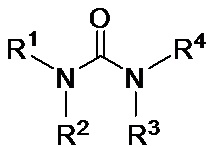FIELD: chemistry.
SUBSTANCE: invention relates to the use of carbamide of the general formula (I), where R1, R2, and R3, the same or different, are a linear or branched alkyl group with 1-12 carbon atoms, R4 is a hydrogen atom or a linear or branched alkyl group with 1-12 carbon atoms, and where carbamide contains a total number of carbon atoms from 17 to 25, as an extractant for complete or partial separation of uranium (VI) and plutonium (IV), without plutonium (IV) reduction to plutonium (III), based on an aqueous solution A1 obtained by dissolution of spent nuclear fuel in nitric acid. In this case, the use provides: a) co-extraction of uranium (VI) and plutonium (IV) from the aqueous solution A1, while co-extraction includes at least a contact in an extractor of the aqueous solution A1 with an organic solution S1 containing carbamide in an organic solvent, and separation of aqueous and organic solutions; b) re-extraction of plutonium (IV) and an uranium (VI) fraction from the organic solution obtained at the stage a) during re-extraction containing at least one contact in the extractor of the organic solution S1 with an aqueous solution A2 containing 0.1-0.5 mol/l of nitric acid, and separation of organic and aqueous solutions; c) complete or partial extraction of the uranium (VI) fraction contained in the aqueous solution obtained at the stage b), while extraction contains at least one contact in the extractor of the aqueous solution with an organic solution S2 containing carbamide in an organic solution, and separation of aqueous and organic solutions; as a result, an aqueous solution containing plutonium (IV), but without uranium (VI), or a mixture of plutonium (IV) and uranium (VI), and an organic solution containing uranium (VI) without plutonium (IV) are obtained. The invention also relates to new carbides.
EFFECT: carbamides of the formula (I) in the presence of an aqueous phase with strong acidity provide coefficients of uranium (VI) and plutonium (IV) distribution, allowing for quantitative co-extraction of these two elements from the aqueous phase, and, in the presence of an aqueous phase with moderate acidity, provide coefficients of uranium (VI) and plutonium (IV) separation, at which uranium (VI) is separated from plutonium (IV) without the need for reduction of plutonium (IV) to plutonium (I).
 (I)
(I)
16 cl, 1 dwg, 3 tbl, 1 ex
Authors
Dates
2022-10-24—Published
2018-06-28—Filed